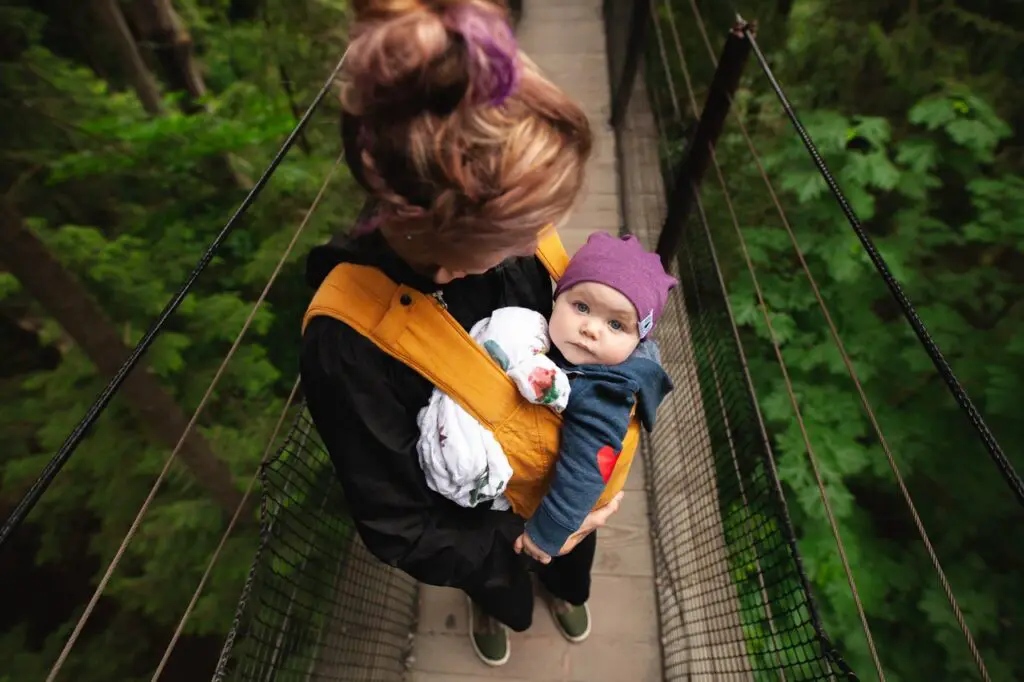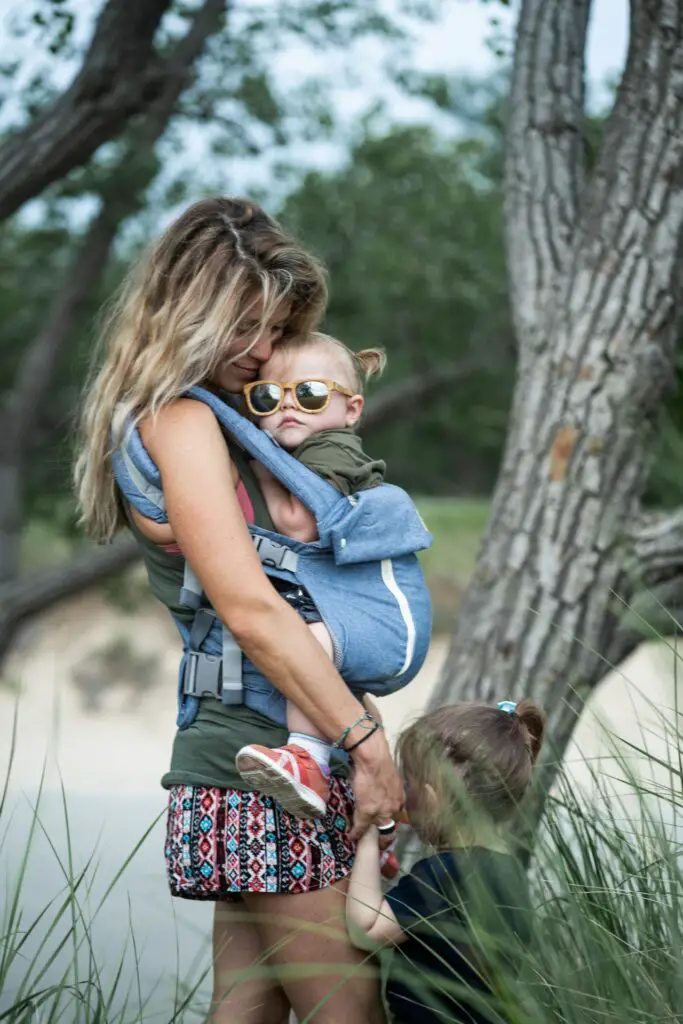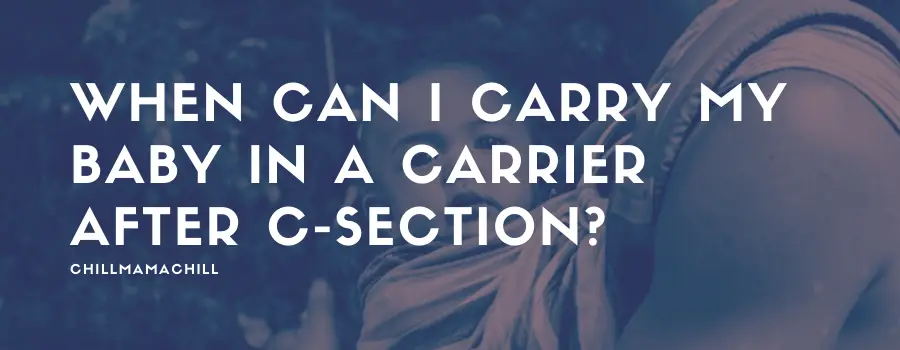You’ve been through the toughest of times carrying your baby and finally delivering it through a cesarean section. However, as time goes by, you earnestly desire to get back to shape and strength and to be able to do normal duties like carrying your baby on a carrier. You’re left wondering; when will I be able to carry my baby in a carrier after C-section?
In most cases, it is safe for mothers who have had C-sections that require no stitching or only very few stitches to breastfeed and carry their babies in a carrier. This can happen immediately after a discharge from the hospital or after a week or two from the date of discharge.
A standard C-section incision is about four inches long. It only requires two to three stitches on average, which normally heals faster, so mothers can wear their babies in carriers almost immediately after giving birth if they desire. However, a good thumb rule for new mothers who are unsure whether it’s safe to carry their newborns in a baby carrier is to wait until their incisions have healed.
In this text, you’ll find out the indicators that it’s safe to use a carrier after C-section, how to safely use the carrier, the alternatives and how long you should carry your baby in a carrier after C-section.
Indicators that it’s safe to use a Carrier to Carry Your Child after C-Section
While any new mom desires to carry their baby conveniently after delivering through C-Section, not all moms get that privilege early enough when they need it.
Some have to wait longer for the healing, while others heal faster and can resume earlier.

Here are some indicators that help you know when it’s safe to use a carrier on your baby:
- When there is no pain or discomfort in the C-section wound
- When there are no signs of infection around it.
- When your baby has an uninterrupted sleep pattern, and you can hold them for long without crying, complaining, or showing signs that they need to pee/poo soon.
- The incisions are no longer draining fluid or appear red and swollen.
- There is no fever present.
These indicators will always vary from one person to another. So, it is better to wait for your doctor’s advice before you start using a carrier with your baby, even if you have all the right indicators.
How to Safely Use your Carrier for the First Time Post-Surgery
When you have a C-section, the most important thing affected in your body is not your belly. It’s the abdominal wall where all the incisions were made during surgery, and it takes time to heal up completely.
So, what do you need to consider when using a carrier for carrying your baby?
The carrier that you are using needs to have good fabric and not too much pressure on it. This will allow your abdominal wall some time to heal up without any external forces acting upon it.
Also, make sure there is no strain on the incision site or stitches when wearing a baby carrier. You do not want anything pulling at your abdominal wall.
And, of course, make sure that you are carrying your baby properly in the carrier and not putting too much pressure on it either! You want to be able to enjoy time with your little one while still taking care of yourself.
What’s more, you need to keep an eye out for complications like bleeding or leaking wound fluid after all this time. This may require a doctor’s visit and further treatment.

In the end, make sure you are listening to your body while carrying your little one in a carrier after C-section surgery. If it hurts or feels weird when putting pressure on that area of your abdomen, then don’t do it.
Alternatives to Carrying Your Child in a Carrier after C-Section
While regular carriers offer the best solution for carrying your little one after C-section, they might not be the right choice for you if the healing process takes a few months.
In this case, you can think of using baby slings and wraps instead.
These carriers are usually not as constricting or weight-bearing as other carriers, making them ideal for cesarean recovery. The sling-type carrier will also allow you to keep your little one close.
However, you may still get some support by using the wrap to help keep your child close. In this case, a cotton-based wrap is best since it will provide more breathability and give you better airflow than a synthetic or wool material.
Soft-structured carriers (SSC) also provide a good solution for postpartum moms as they offer a more ergonomic design than traditional slings and wraps while having similar benefits.
The SSC distributes the baby’s weight across your hips and shoulders instead of just your shoulders as traditional slings do. Here’s a video on how to use an SSC.
This will help to prevent any back pain, which can occur during recovery.
Lastly, if none of these carriers appeals to you for cesarean recovery, then you may want to stick with a front-carrying carrier for your baby.
This way, you can keep all of the pressure off your cesarean site but still have both hands free to tend to other things.
How Long Should I Wear my Baby in a Carrier After C-Section?
After you’ve found the right carrier to use after C-section, you should also know how to use it to minimize the re-occurrence of injuries. One way to do that is by using the carrier for the desired duration of time.
The amount of time you spend carrying your baby in a carrier after a C-section depends on multiple factors. These include the type of cesarean, recovery progress, and any complications that may have occurred during or after surgery.
Carrying your baby in a carrier after C-section is usually safe, but, like any other activity you do with the baby, it should be done appropriately and within a time limit.
Anything below one hour is acceptable, but keeping the carrier on for too long can apply strain and stress on the wound, leading to infection.
To avoid aggravating the injury, you should consult your doctor before any activity with the baby – including using a carrier. They will advise you about how long and how often you should carry your baby in a carrier after C-section surgery so as not to cause any damage.
Bottom Line
It is safe to carry your baby in a carrier after C-section as long as the doctor gives you the go-ahead. Some moms may start using carriers immediately after delivery; others may take two weeks before starting, while others may wait longer.
The rule of thumb is to wait for total recovery if you’re unsure of when to start. But if your doctor has okayed using a carrier, you should continue using one under your doctor’s instructions.

I’m Cathrine and I’m a 39-year-old mother of 3 from Utica, New York. And I’m extremely happy you’ve come to visit my hide-out on the web. Here I post about everything related to family-life and usually it will involve babies and lessons I’ve learned over the years from experts, friends, and my own mistakes. So hopefully you will find what i write fun and informational!

